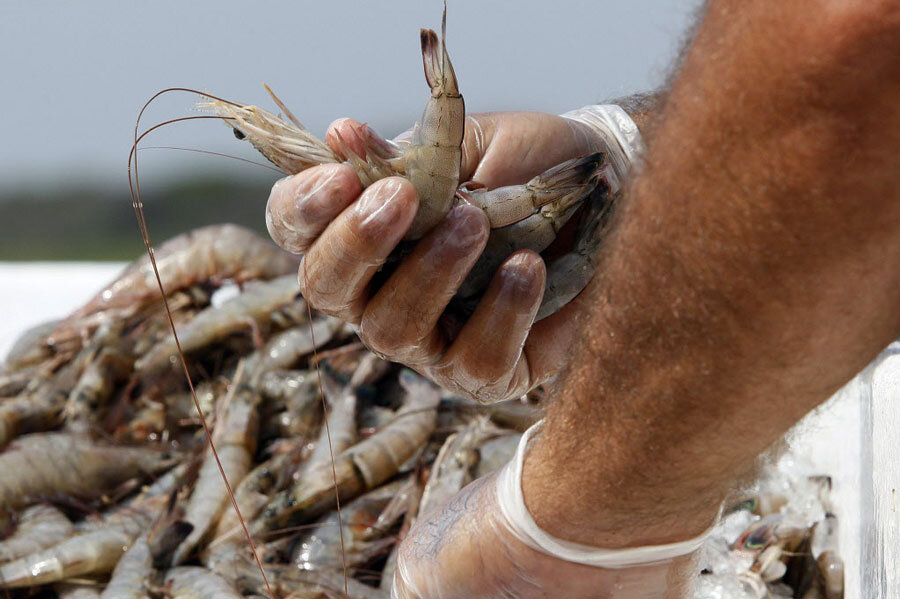One out of 3 shrimp sold in US comes in fishy packaging
Loading...
Confirming suspicions among many consumers, the ocean watch group Oceana on Thursday revealed that one of every three shrimp consumed in America is a poseur.
“With shrimp, it is almost impossible to know what you are really getting,” says Kimberly Warner, the lead researcher, in the new study.
Producers, grocery stores, resellers, shippers, and restaurants, the group’s DNA study shows, routinely mislabel the origin of their crustaceans, which has health and ethical implications for consumers. (Oceana found last year that one-third of all finfish sold in the US is also mislabeled.)
For the most part, the US, which has been called a “popcorn shrimp nation” as it consumes 1 billion pounds a year, hasn’t done much to clear up all the confusion. Washington is trying, though, as President Obama in June set up a presidential task force aimed at corralling mislabeling in order to help consumers make more informed and ethical choices when it comes to seafood.
The issue has international implications, as the US imports 91 percent of its seafood, mostly from friendly trade partners like Thailand, Indonesia, and India, which all employ Washington lobbyists to keep the seafood swimming in to meet America’s prodigious appetite for fish and shrimp. But the US State Department in June did report that some Thai shrimp farms use feed that includes fish caught by slaves.
Given such ethical stakes, “seafood fraud misidentification – substitution of one product for another – has economic costs as well as undermines the ability of our buying public to be able to accurately and effectively identify what it is they’re consuming and where it’s coming from,” Russell Smith, deputy assistant secretary for International Fisheries, told the taskforce in August.
Congress has struggled to clear up similar issues in the past. Just look at catfish. Via a law passed in 2003, only US-caught catfish is supposed to be called catfish, yet most of the “catfish” advertised and eaten in the US these days comes from Vietnam. (Meanwhile, the US catfish farming industry, already struggling to compete on price, is in a shambles after ethanol demands drove up feed costs on an already low-margin endeavor.)
The situation is even worse with shrimp. The sale of farmed “whiteleg” shrimp as “wild Pacific shrimp” is common, according to Oceana. Those whitelegs could easily be coming from farms in Southeast Asia, “where environmental and human rights experts have long identified labor rights abuses, hazardous working conditions, damage to ecosystems and the use of hormones and antibiotics,” The New York Times wrote recently.
Another case study: The famous Royal Red shrimp, whose flesh is considered almost lobster-like and can only be found by shrimpers in two locations on the Gulf Coast. None of the shrimp labeled Royal Reds actually were Royal Reds in the Oceana study.
The study found that deception was worst in New York City, where 43 percent of shrimp were misrepresented, and where more than two-thirds of grocery stores sold shrimp packaged with untrue claims.
Part of the problem, Ms. Warner says, is that US consumers aren’t really complaining too loudly. Shrimp has in many ways become seen as a commodity. There are 41 species in the world that can be sold as just plain old “shrimp,” with no further explanation.
“Somewhere along the line, shrimp went from being that special thing to something you can gorge yourself on,” Ken Peterson of the Monterey Bay Aquarium told The New York Times’ Kim Severson in August.
Discerning consumers, however, do have ways to ensure that their wild shrimp from Alabama actually is wild shrimp from Alabama – not slave-labor-tainted shrimp from Thailand.
High-end grocery stores such as Whole Foods have their own tracing systems, as well as outside auditors. And several big-box retailers – BJs, Costco and Walmart among them – utilize third-party auditors to make sure they’re representing their products accurately, including point of origin and catch methods.
But some shrimp lovers go to even greater lengths to make sure they’re getting the actual shrimp being advertised.
“I no longer eat shrimp in restaurants unless I’m someplace like the coast of Mississippi, Maine or South Carolina at a reputable restaurant I know has a local supplier of non-farmed shrimp,” writes Larry Olmsted, on Forbes.com. “When I buy shrimp for cooking I will only buy wild caught Gulf of Mexico shrimp that comes with independent third party confirmation from a reputable group like the Marine Stewardship Council (MSC), because … a ‘wild caught’ label is not enough, you need this claim to be audited.”






